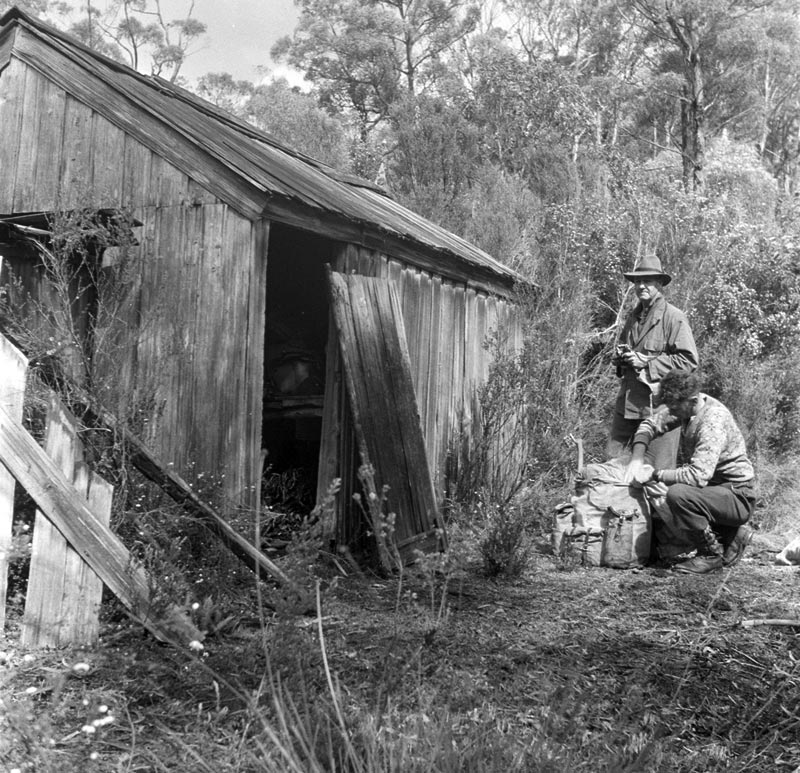The Jane River goldfield, which came to prominence at the time of the 1930s depression, was Tasmania’s last gold rush. Active prospecting and exploration for gold was still going on strongly up to the time that the area was declared part of the Franklin – Gordon Wild Rivers National Park, and incorporated into the Tasmanian Wilderness World Heritage Area.
First find of gold
There had been tantalising reports of gold in the Mt. Arrowsmith area for many years prior to this, but no significant find until the beginning of 1895. This was the result of a 3-month expedition to the belt of country between Mt Lyell and the juction of the Franklin and Surprise rivers, in spring of 1894. The expeditioners succeeded in finding gold in the “eastern branch” of the Jane River (perhaps Erebus Rivulet or Algonkian Rivulet).
Almost 15 years later, in 1909, an official survey of the area of the Jane and Loddon rivers was carried out by L.K.Ward, then Assistant Government Geologist. The only interesting find of the expedition was the finding of some gold in the Jane River.
Prospecting trips in 1931 and again in 1933 failed to find anything of value. Then in 1935 news started to come out that Robert Warne had applied for a reward lease to work a payable find of alluvial gold in the upper Jane River.
The reward lease
Robert Warne was granted a 30 acre reward claim, which he worked on and off until 1952. Some of his early prospects were very rich, and he described getting an ounce and a half of gold out of four dishes of gravel in his first prospect on Reward Creek. During his second visit to the field, also in 1935, he got 30 ounces for two weeks work. During the 17 years he worked his reward claim (1935-1952), he recorded mining a total of 744.5 ounces of gold.
Not everyone had such good fortune. Some prospectors, as seems to happen in every goldfield, left in disgust. Letters to The Mercury, and signs posted on the track that September warned prospectors that the goldfield was “not worth the trouble of getting there”. By the end of 1935, Robert Warne had for company at least 36 other prospectors who had pegged out claims in the vicinity. Some of them claimed to have done quite well by the time they left. The main workings were on the headwater tributaries of Ridge Creek, south of the ridge between Warnes Lookout and Algonkian Mountain.
1940s-1990
Prospecting continued uninterrupted in the area until the 1980s. Although quite rich alluvial, the hard-rock source of the Jane River gold was never found. The terrain and the vegetation made traditional prospecting difficult. Loaming peaty ground would be just about impossible.
In spite of this, commercial exploration was carried out starting in the 1960s. Mt Lyell-EZ, Mount Costigan Mines, BHP and the ‘Jane River Syndicate’ all had a go before the area became unavailable. Their reports are in the links section below. The area was still held as a consolidated lease at the time that the area was declared part of the Wild Rivers National Park. Some reports, such as the comprehensive report by Newnham Exploration in 1990, were written after the area was reserved.
At the time the area was protected and prospecting banned, the extent of the goldfield wasn’t yet known, there was rich alluvial still being found, and the hard-rock source of all that gold had never been found. Newman summarises the feeling about the Jane River area in 1990 quite accurrately by saying: “Under normal circumstances, this newly recognised potential would be vigorously pursued by most serious gold exploration companies”.
Access today
If you want to have a play in the Jane River goldfield today, you’re out of luck, or 25 years too late. The whole area is part of the Franklin – Gordon Wild Rivers National Park, and also part of the Tasmanian Wilderness World Heritage Area. No fossicking, prospecting or mining is allowed at all.
Whatever possessed the Mines Department to agree to the Jane River area becoming part of the national park, we probably will never know. As a result, the area gets regularly poached by people wanting to find some gold, and this is then used by the authorities as an excuse restrict what all the rest of us are allowed to do elsewhere.
Jane River goldfield links
The main Jane River reports I’ve been able to find in the Mineral Resources Tasmania database are:
- Ward (1909). Report on the Loddon and Jane Rivers.
- Blake (1935). Preliminary Report on the Jane River Goldfield.
- Blake (1935). Alluvial Cinnabar at Jane River District.
- Blake (1936). Report on district between Jane River and Prince of Wales Range.
- Solomon (1968). Preliminary Report on the Jane River Goldfield, Tasmania.
- Hall, et al. (1969). E.L. 13/65 South-West Tasmania Geological Report 1966-67.
- McKenna & Co (1976). Inspection Report on Reward Creek Gold Area.
- Bacon (1989). A brief history of the Jane River goldfield.
- Newnham (1990). Review of Geological Data and Resource Potential Reward Creek Area, Jane River Goldfield.
Do you have any stories of prospecting the Jane before it was made into a National Park? We’d love to hear it, so please feel free to write it as a comment below. If you like the content at Apple Isle Prospector, feel free to get in contact, or leave a comment. If you enjoyed this article, then let others know by sharing it on Facebook or liking our Facebook or Twitter pages:




Been enjoying reading you’re posts,
Always interesting,.. Thanks.
Ps I heard somewhere that apparently quite a bit of gold found isn’t really found and it is or was a main way of laundering money,just thought I would mention it, you probably all ready know! Cheers
Thanks!
It would be impossible to know, I suppose. In the old times banks kept records of how much gold prospectors sold to them, but I guess even those could be faked. Still, by all reports the Jane was a decent goldfield, and all the more alluring because we will never know the true size and extent of it.
Great site! Well researched and very good reading. One of the best gold and history sites I ever seen.
The crapola about banning fossickers and any kind of prospecting, is what I expect from Australians. No, is their favourite word!
And yes, like you, I find it facetious that the Jane was annexed. Just good old ‘ozzie’ bloody-mindedness.
BTW, I was born here nearly seventy years ago.
Thanks mate,
I think someone was asleep at the wheel when the whole thing happened, the result is that the Jane will always be ‘the one that got away’, and much more likely to get poached.